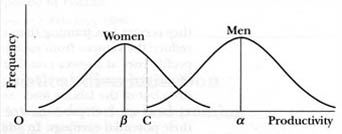5.3.2 Productivity difference
The preceding discussion has only considered what would happen if all women undertake less investment in human capital than men. If men and women invest to the same extent, human capital theory suggests that no wage differences would be observed. What happens, however, if there are differences in skill levels both between genders and within gender groups? To consider this we will also make the additional assumption that firms do not know when recruiting workers who are the most productive. However, employers do know that, on average, women spend less time in the labour market than men because of career interruptions.
Figure 4 can be used to describe what will result. Since firms do not know each individual's potential productivity when hiring – both men and women may leave or may not be very productive once trained – they will set wages on the basis of what they do know, and that is the average level of productivity of each group. Since women have less training and work experience, their average level of productivity will be lower than men's. The two distributions show that there are variations in productivity among men and women. The fact that they overlap indicates that some women are more productive than some men. Let α be the average productivity of men and β the average productivity of women (α > β).

For a man, individual productivity is equal to:
![]() i =
i = ![]() + ui
+ ui
whereas for a woman, it is likewise equal to:
![]() i =
i = ![]() + ui
+ ui
where ui represents the individual difference between actual productivity and the average for all men (women).
The average level of human capital investment, and thus productivity, differs between men and women and this is reflected in the average earnings differential. On these assumptions, there is no discrimination, on average, against women. However, there is discrimination against individual women. Specifically, those women who have a productivity level to the right of the line above point C are being paid less than comparable men. It is also evident that the greater the variation in productivity within the female group, the more women will be underpaid compared with men who may be less productive. The curve showing the distribution of productivity would be wider, and, hence, there would be more overlap with the distribution curve for men. Discrimination here involves the unequal treatment of individuals on the basis of actual or perceived differences in the average characteristics of the groups to which they belong.
An additional point about potential productivity concerns the methods used by firms to try and identify which applicants are potentially the best employees. Firms use a variety of ‘screening devices’ when recruiting in order to establish the best potential employees. One such device is psychometric testing which many firms are now using to test applicants. However, it is possible that the very nature of these tests may be biased against women or minority ethnic groups, adding further to the discrimination faced by individual workers.
Bringing selection procedures back on track
In early 1991 several ethnic minority guards at Paddington Station took British Rail to an industrial tribunal, alleging that the selection process for train drivers discriminated against applicants from minority ethnic groups. In a settlement, BR agreed to work with the CRE to make the selection process fairer.
One element of this was a workshop with the Paddington guards to explore their test-taking behaviour. It became apparent that they were not, as the Americans say, test-wise. As a result, British Rail commissioned an open-learning pack which the guards could work on in their own time before retaking the test in September 1992
The pack gave advice and tips on how to develop successful test-taking behaviour, as well as extensive practice materials to develop language proficiency. Six weeks were allowed, and the pack was supported with workshops at the beginning and at the end. The result? Five of the seven guards passed the tests and have gone forward for training.
Source: Personnel Management, December 1992
